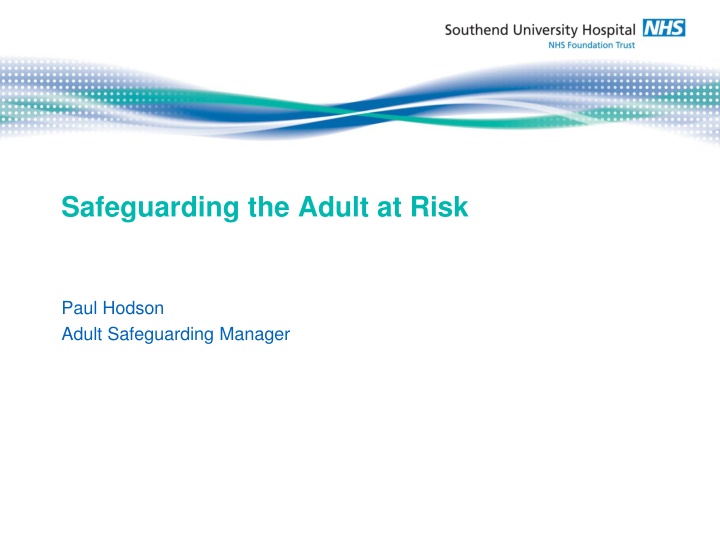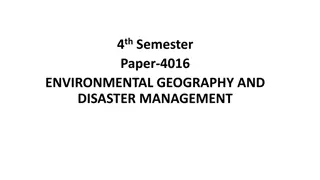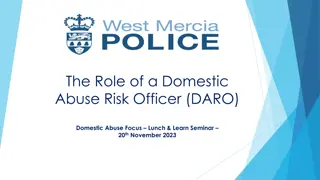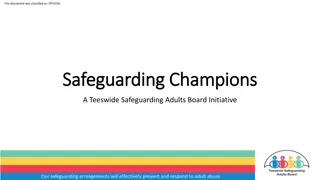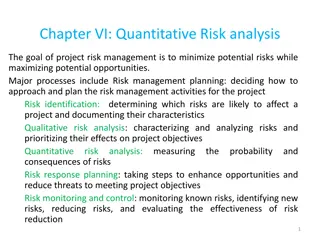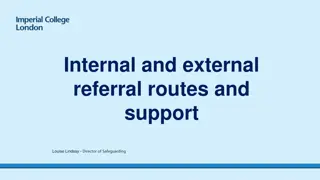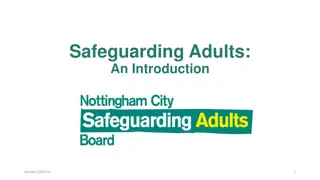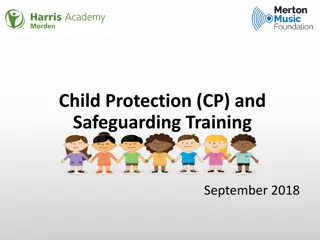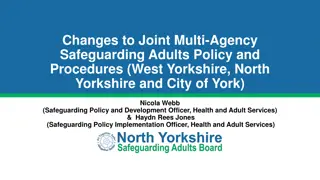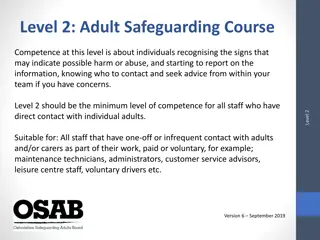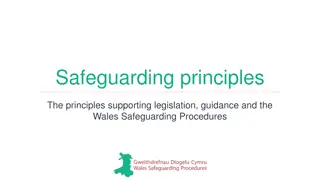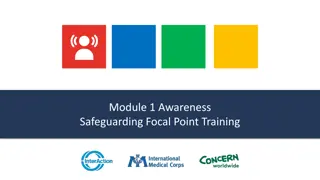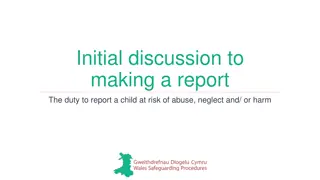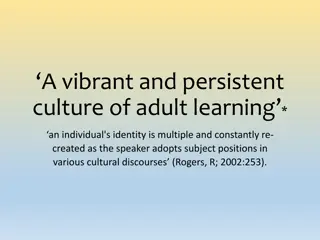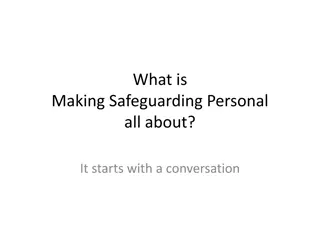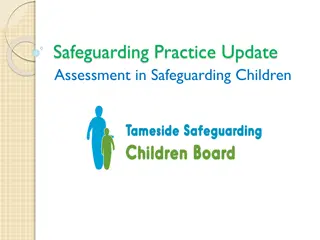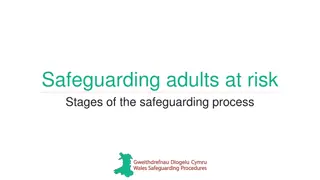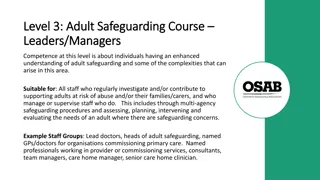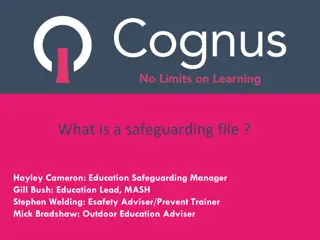Safeguarding the Adult at Risk
Adult safeguarding is a crucial aspect of protecting vulnerable adults from abuse and neglect. This session covers key definitions, legislation, and responsibilities surrounding adult safeguarding. Topics include identifying abuse, the safeguarding process, mental capacity assessment, Deprivation of Liberty Safeguards, and contact information for reporting concerns. The Care Act 2014 has introduced significant changes to safeguarding practices, emphasizing the duty to enquire, the establishment of Safeguarding Adults Boards, and requirements for Safeguarding Adults Reviews. Safeguarding is a collective responsibility that aims to ensure the safety and well-being of adults at risk.
Download Presentation

Please find below an Image/Link to download the presentation.
The content on the website is provided AS IS for your information and personal use only. It may not be sold, licensed, or shared on other websites without obtaining consent from the author.If you encounter any issues during the download, it is possible that the publisher has removed the file from their server.
You are allowed to download the files provided on this website for personal or commercial use, subject to the condition that they are used lawfully. All files are the property of their respective owners.
The content on the website is provided AS IS for your information and personal use only. It may not be sold, licensed, or shared on other websites without obtaining consent from the author.
E N D
Presentation Transcript
Safeguarding the Adult at Risk Paul Hodson Adult Safeguarding Manager
Aims of the session Definitions, Legislation and Guidance Who abuses and who is at risk of abuse Types of Abuse Alert/Referral Process Domestic Violence Safeguarding & consent & Information Sharing Local Safeguarding Process PREVENT Understanding how mental capacity is assessed Understanding the need for a Deprivation of Liberty Safeguard and how it is applied for Who to Contact
In Groups What is safeguarding? Whose responsibility is safeguarding? Are we responsible for safeguarding everyone? What are we safeguarding and protecting from? Are we safeguarding from intentional or non-intentional harm? If a patient falls and injures themselves in our care is that considered abuse? Who can be a person alleged to have caused harm? Where can abuse occur?
What is Adult Safeguarding Adult safeguarding is working with adults with care and support needs to keep them safe from abuse or neglect. It is an important part of what many public services do, and a key responsibility of local authorities
Legislation and Guidance Human Rights Act 1998 No one shall be subjected to degrading treatment Mental Capacity Act 2005 The Presumption of capacity Multi-Agency Policy and procedures to safeguard adults from abuse The Care Act 2014
The most significant changes to Safeguarding brought about by the Care Act 2014 A duty to enquire on the part of the local authority when a person with support needs (at whatever level) may be experiencing abuse and may not be able to protect themselves An obligation on the local authority to establish a Safeguarding Adults Board (SAB) which must publish an annual action plan and report New provisions for Serious Case Reviews, now renamed Safeguarding Adults Reviews, including obligations to share information with the Safeguarding Adults Board
Principles of Safeguarding Adults Empowerment person led informed consent Protection Support and Representation Prevention- Before harm occurs, the wider context of safeguarding adults through effective high quality and personal care Proportionality least intrusive response Partnership with communities Accountability transparency in safeguarding
Who is at risk of abuse? Safeguarding is aimed at people with care and support needs who may be in vulnerable circumstances and at risk of abuse or neglect. In these cases, local services must work together to spot those at risk and take steps to protect them.
The Care Act 2014 defines an adult with care and support needs and may be at risk of abuse as someone who: has needs for care and support (whether or not the local authority is meeting any of those needs) is experiencing, or at risk of, abuse or neglect as a result of those care and support needs is unable to protect themselves from either the risk of, or the experience of abuse or neglect. is someone over the age of 18.
In Groups Come up with a list of categories of adults at risk
Who may be considered At Risk? Older people People with a Learning Disability People with Physical Disabilities /sensory disability Mental Illness/ Alcohol and Drug Misuse Domestic Violence and Abuse Victims Dementia, Cognitive impairment Unconscious, anaesthetised or chemically restrained A person who lacks capacity First Language not English
In Groups Come up with a list of categories of types of abuse / harm
What is Abuse? A violation of an individual s human or civil rights by any other person or persons. This may consist of a single act or repeated acts.
Types of abuse Physical Domestic violence Sexual Psychological Financial or material Modern slavery Discriminatory Organisational Neglects and acts of omission Self neglect
Also consider Disability Hate Crime Mate Crime Female genital mutilation Forced marriage Hate Crime Honour-based violence Radicalisation
Who may perpetrate harm / abuse? The person responsible for perpetrating harm is often well known to the victim and could be: A paid carer or volunteer A nurse, doctor, social care or other worker A relative, friend or neighbour An occasional visitor or someone who is providing a service People who deliberately exploit vulnerable people
Signs of abuse Physical signs Behavioural changes Emotional changes Disclosure
Modern Slavery Slavery still exists even in the UK Number of potential victims in UK is between 10,000 13,000 victims (2013) Modern slavery encompasses slavery, servitude, forced and compulsory labour and human trafficking Can be individual perpetrators or larger organised crime groups
Types of modern slavery Child trafficking Forced labour Debt bondage Forced labour Sexual exploitation Criminal exploitation Domestic servitude
Signs of slavery Physical appearance Isolation Poor living conditions Few or no personal effects Restricted freedom of movement Unusual travel times Reluctance to seek help
Modern slavery strategy Aim: to reduce significantly the prevalence of modern slavery
Modern Slavery Strategy PURSUE: Prosecute and disrupt individuals and groups responsible for modern slavery PREVENT: Prevent people from engaging in modern slavery PROTECT: Strengthen safeguards against modern slavery by protecting vulnerable people from exploitation and increasing awareness of resilience against the crime PREPARE: Reduced the harm caused by modern slavery through improved victim identification and enhanced support
Modern Slavery Helpline 0800 0121 700
Definition Any incident or pattern of incidents of controlling, coercive, threatening behaviour, violence or abuse between those aged 16 or over who are, or have been, intimate partners or family members regardless of gender or sexuality. The Abuse can encompass but not limited to: psychological, physical, sexual, financial, emotional (Ref: Home Office 2015)
Controlling Behaviour Controlling Behaviour is a range of acts designed to make a person subordinate and/or dependant by: Isolating them from sources of support Exploiting their resources and capacities for personal gain Depriving them of the means needed for independence, resistance and escape Regulating their everyday behaviour
Coercive Behaviour Coercive Behaviour is: An act or pattern of acts of assault, threats humiliation and intimidation or other abuse that is used to harm, punish, or frighten their victim.
MARAC (Multi agency risk assessment conference): A local multi-agency forum of organisations that manage high risk cases of domestic abuse, stalking and honour based violence. MARAC is a meeting where information is shared on the highest risk domestic abuse cases between representatives of local police, probation, health, children and adults safeguarding, housing, substance misuse services, independent domestic violence advisors and other specialists from statutory and voluntary sectors.
How to escalate a concern? Speak to a member of the Safeguarding Teams or a MARAC Lead. Further guidance and referral pathways within the Domestic Violence Policy (Intranet). Freephone 24 Hour National Domestic Violence Helpline: 0808 2000 247
Undertaking Risk Assessments for Safeguarding Assess the situation e.g. Are the emergency services required? Ensure the safety and wellbeing of the individual Inform the person that you are required to share the information explain what will be shared and why. Record what the person has told you, using their words and actions
Consent Explain concerns and seek patient s views Obtain consent if patient is able and willing Proceeding without consent may be considered when: - Public safety interest - Child under 18 - Crime committed - Best Interest Decision (if no capacity) - High level of risk
How to raise an alert Complete a SETSAF 1 and ensure that this is delivered (electronically or by fax) immediately to Social Services and confirm receipt Ensure a copy of SETSAF 1 is maintained in the patient record and forwarded to the Adult Safeguarding Team Where it is alleged that suspected abuse has occurred within the Trust (not in the community) a SETSAF must be completed within 4 hours. An incident form must be completed. Refer to CM55 [T2] SETSAF1 guidance notes for more information. The most senior nurse /manager or Adult Safeguard Lead must contact the police if a criminal offence has been committed or is suspected. This will be escalated during hours to the Associate Director of Governance. If required out of hours, the Clinical Site Manager will escalate to the Senior Manager on call
Main stages of a safeguarding concern Stage 1 Alert Immediate Action to safeguard anyone at immediate risk (immediate if emergency or same day within 4 hours) Stage 2 Referral- Document and inform multiagency partners (immediate or within 24 hours) Stage 3 Enquiry Safeguarding Enquirer (Social Worker) appointed and thorough investigation/assessment of risk level Stage 4 Concluding the enquiry and protection plan
Barriers in alerting or referring to and Whistle blowing Staff may notice or come across practice that they think is untoward Staff may be worried that by reporting issues of concern, they could be exposing themselves to possible victimisation, disciplinary action or putting their job at risk The Trust is committed to developing a culture of openness and accountability. It is very concerned about the potential effect of these matters on the services we provide. The Speak Up (Whistle blowing) Policy brings together existing guidelines to set out the responsibilities of staff and other workers and the procedures to be used when raising particular issues of concern The Trust will ensure all staff are fully supported when raising concerns and that these are fully investigated.
Information Sharing Data Protection Act is not a barrier to sharing information Be open and honest about how information will be shared Seek advice if in doubt Share with consent where appropriate Consider safety and wellbeing of person and others involved Necessary, relevant, proportionate timely and secure Keep a record of your decision and reasons for it
What not to do... Don t Ignore Duty of Care/Professional Responsibility Press person for more details Promise to keep secrets Make promises you can t keep Contact/approach the alleged abuser Be judgemental ( why didn t you try and stop them ? ) Sit on the information over the weekend until you are next on duty, etc. Report immediately. Assume other will act (responsibility lies with you)
Prevent Strategy - Reducing risk of radicalisation and terrorism Aims to prevent people from being drawn into terrorism and ensure that they are given appropriate advice and support
Prevent is part of existing safeguarding responsibilities Prevent is part of existing safeguarding responsibilities for the health sector, not an additional job Healthcare workers have the opportunity to refer vulnerable individuals for support in a pre-criminal space by: - Recognising vulnerable adults, children and young people who may be at risk of radicalisation; - Working in partnership to reduce risk and protect the individual and - Providing adequate and necessary support as part of a proportionate multi-agency response to any concerns.
Vulnerability factors Radicalisation is a process, not one off event. There is no single profile of a terrorist there is no checklist to measure someone against. This is not about race, religion or ethnicity - the programme is to prevent the exploitation of susceptible people.
Engagement Intent Capability Over-identification with a group or ideology Them and Us thinking Dehumanisation of the enemy Attitudes that justify offending Harmful means to an end Harmful objectives Feelings of grievance and injustice Feeling under threat A need for identity, meaning and belonging A desire for status A desire for excitement and adventure A need to dominate and control others Susceptibility to indoctrination A desire for political or moral change Opportunistic involvement Family or friends involvement in extremism Being at a transitional time of life Being influenced or controlled by a group Relevant mental health issues Individual knowledge, skills and competencies Access to networks, funding or equipment
What to do Recognise, Understand and Share Concerns Report any Prevent related concerns Further guidance available Search Building Partnerships, Staying Safe Department of Health guidance for staff and organisations https://www.gov.uk/government/publications/buildi ng-partnerships-staying-safe-guidance-for- healthcare-organisations
Dignity/compassion/respect The 10 principles of dignity challenge Have a zero tolerance of all forms of abuse Treat all with the same respect you would want for yourself or another member of your family Treat people as an individual by offering a personalised service Enable to maintain the maximum possible level of independence, choice and control
cont.. Listen and support people to express their needs and wants Respect people s right to privacy Ensure people feel able to complain without fear or retribution Assist people to maintain confidence and positive self esteem Act to alleviate peoples loneliness and isolation
What is mental capacity? Mental capacity is broadly defined in the Act as the ability to make decisions. These may be decisions which affect daily life, or more serious decisions which may have legal implications Applies to people age 16 years and over
The Mental Capacity Act 2005 Presume all patients have capacity unless they do not satisfy the MCA test Maximise capacity for patients who are unable to make decisions All patients have a right to make decisions for themselves even if unwise Always act in the patient s best interests using the MCA steps Consider alternatives to ensure the least restrictive option
